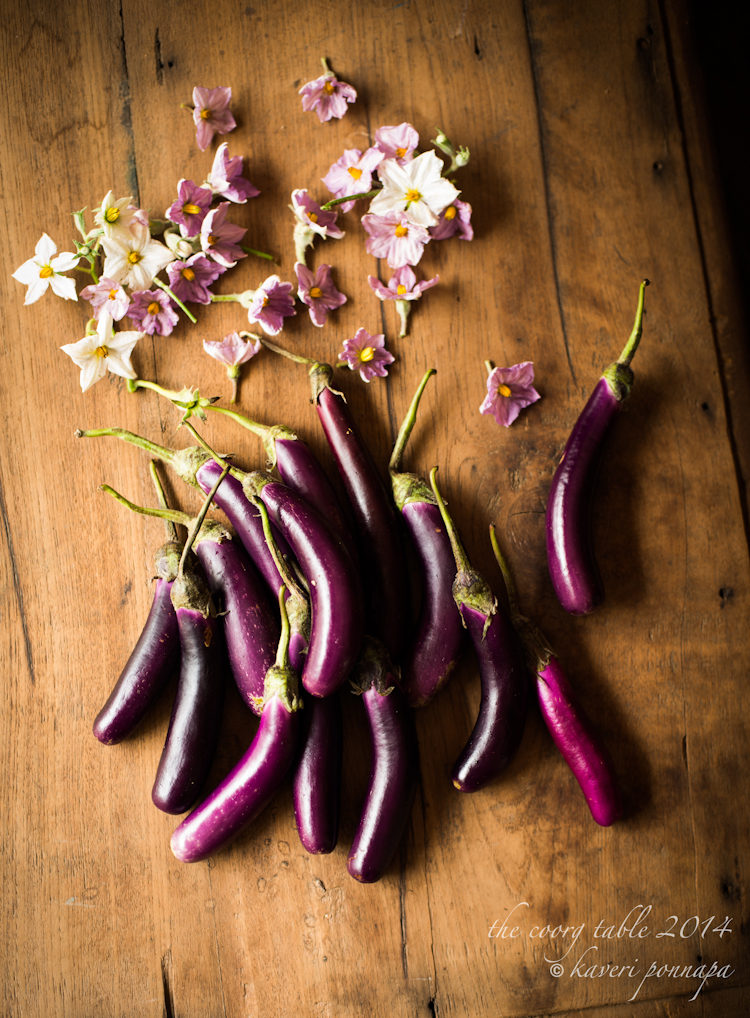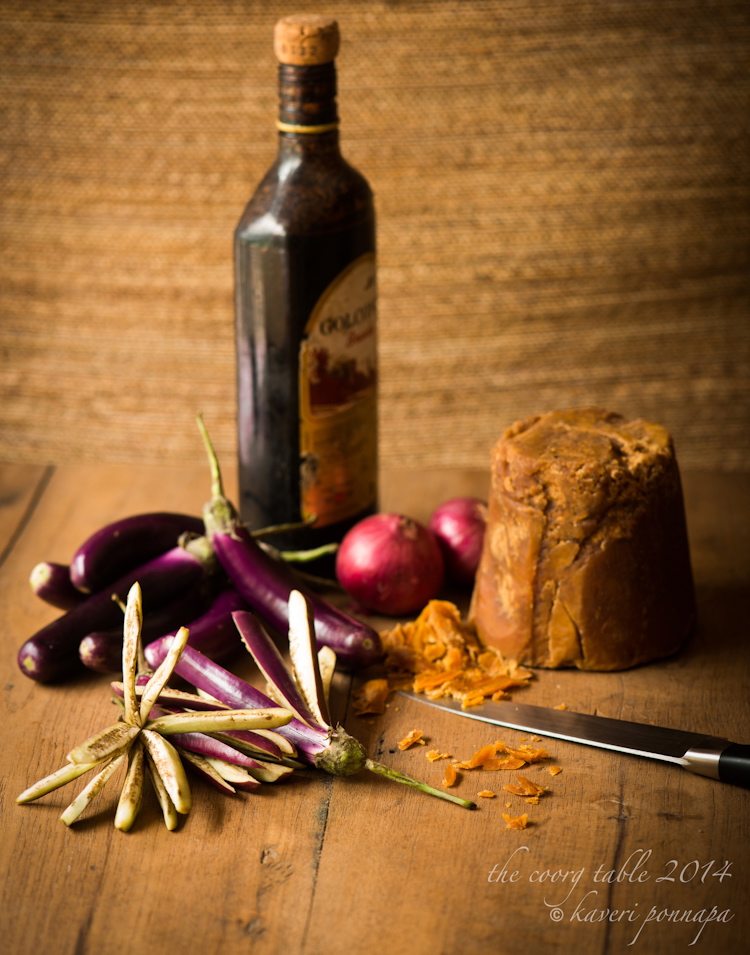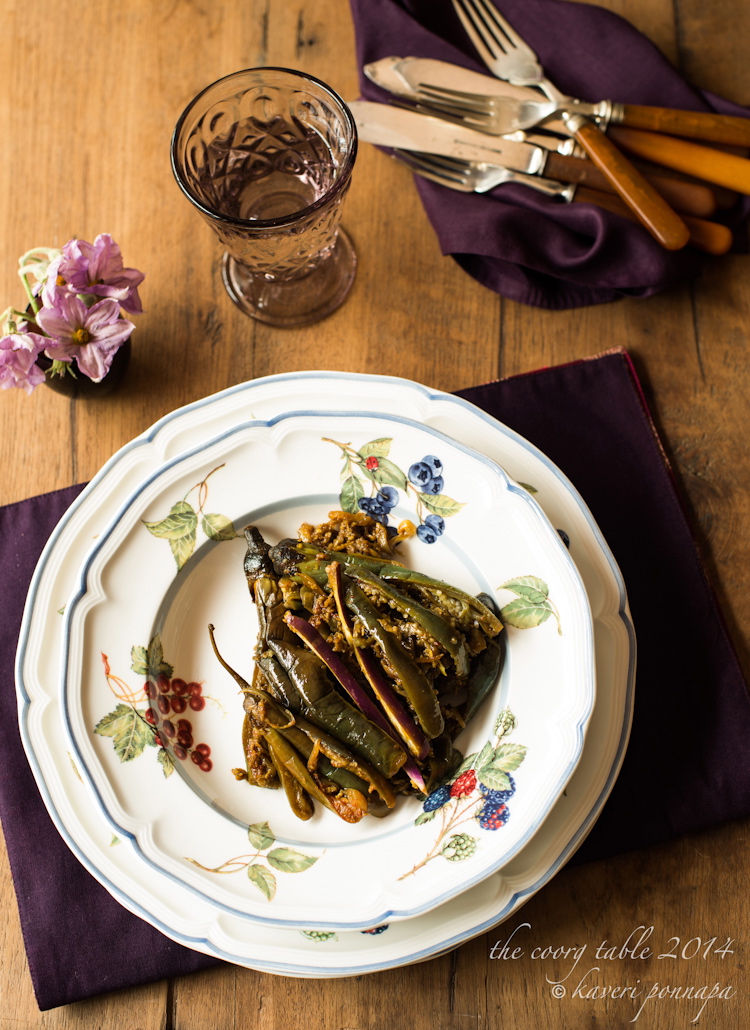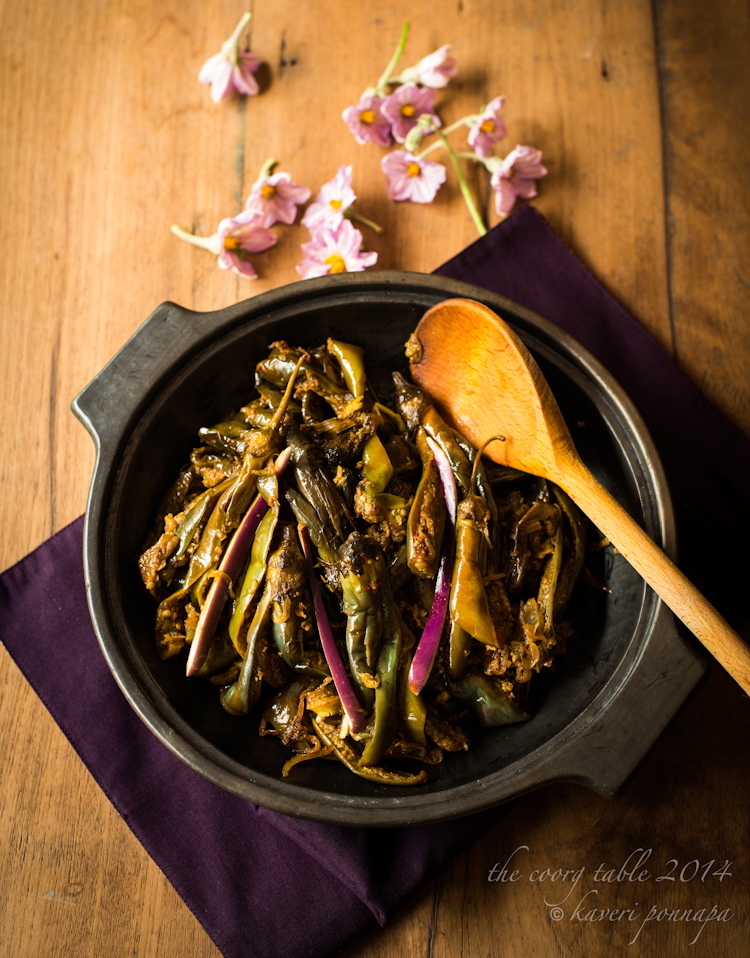In the rush of everyday cooking, it’s often easy to overlook the beauty and individuality of very ordinary ingredients. Take the familiar aubergine, for instance. It comes in so many shapes, sizes and colours – round, large, shiny purple, pale green, white striped and streaked. It grows easily in back gardens and you can see it heaped up on vegetable carts, and arranged in formidable ranks like some shining, armour-plated army in vegetable markets. Its flowers, usually ignored, are lavender, papery and very pretty.  Mostly taken for granted, or snapped at, when errant bristles from the stem stab at fingers when washing or trimming it, the aubergine is in fact a contrary beauty. It is a fruit, but always cooked and eaten as a vegetable. Its firm, shiny skin is always cool, smooth and silken, a pleasure to run your hands over, until your fingers snag with small, sharp barbs on the stem. Spongy, flecked with seeds, carrying bitter undercurrents, it quickly loses its gleaming beauty when cooked, dissolving into an unattractive mess and, what flavours it yields depends entirely upon the cook.
Mostly taken for granted, or snapped at, when errant bristles from the stem stab at fingers when washing or trimming it, the aubergine is in fact a contrary beauty. It is a fruit, but always cooked and eaten as a vegetable. Its firm, shiny skin is always cool, smooth and silken, a pleasure to run your hands over, until your fingers snag with small, sharp barbs on the stem. Spongy, flecked with seeds, carrying bitter undercurrents, it quickly loses its gleaming beauty when cooked, dissolving into an unattractive mess and, what flavours it yields depends entirely upon the cook.  My husband has always been the greatest admirer, supporter – and consumer – of my cooking ever since the day we met. Over the years, he maintained a prudent silence on his mother’s formidable cooking skills, and barely referred to them, except for her bainay barthad, fried aubergine. He described it in such vivid detail, that my mouth watered, and the next time we visited the family home, I mentioned this to her. Looking surprised and pleased, she quickly put together all the ingredients, and proceeded to demonstrate how to cook them. Taking care to keep the stem intact, she spent what seemed like most of the morning slicing the aubergines thin and frilly, painstakingly working on each individual piece, making sure she kept the slicing neat and even. As she sliced, they fanned out prettily, and she plunged them into cold water to keep them from discolouring. Once they were ready, it did not take her long to fry them, adding a dash of this and a bit of that in sharp, quick movements. The result was the ugliest looking fry that I had ever seen. All the beautiful purple had vanished, to leave behind a tangled mass of dark brown tentacles, which is what remained of the delicate frills. I stared, wondering about the wasted effort, and then hesitantly, tried a little – just a very little. It was delicious. I worked my way through a large helping, and although I did not know it then, this was the dish that would start a long and wonderful correspondence about food with my mother-in-law. In the years we lived overseas, I would write and ask her for a recipe and the reply would come on sheets of pale blue paper. I still have many of these letters, with recipes, instructions and assorted bits of family news and gossip written across them.
My husband has always been the greatest admirer, supporter – and consumer – of my cooking ever since the day we met. Over the years, he maintained a prudent silence on his mother’s formidable cooking skills, and barely referred to them, except for her bainay barthad, fried aubergine. He described it in such vivid detail, that my mouth watered, and the next time we visited the family home, I mentioned this to her. Looking surprised and pleased, she quickly put together all the ingredients, and proceeded to demonstrate how to cook them. Taking care to keep the stem intact, she spent what seemed like most of the morning slicing the aubergines thin and frilly, painstakingly working on each individual piece, making sure she kept the slicing neat and even. As she sliced, they fanned out prettily, and she plunged them into cold water to keep them from discolouring. Once they were ready, it did not take her long to fry them, adding a dash of this and a bit of that in sharp, quick movements. The result was the ugliest looking fry that I had ever seen. All the beautiful purple had vanished, to leave behind a tangled mass of dark brown tentacles, which is what remained of the delicate frills. I stared, wondering about the wasted effort, and then hesitantly, tried a little – just a very little. It was delicious. I worked my way through a large helping, and although I did not know it then, this was the dish that would start a long and wonderful correspondence about food with my mother-in-law. In the years we lived overseas, I would write and ask her for a recipe and the reply would come on sheets of pale blue paper. I still have many of these letters, with recipes, instructions and assorted bits of family news and gossip written across them. Bainay barthad, with its messy, unappetizing looks is such a contrast to the flavour it offers. The soft, spongy texture of the flesh absorbs the sour from kachampuli, the Coorg vinegar, and presents a mixture of spice from red chilli powder, sweetness from a little bit of jaggery and a faint bitterness all its own. On the table, I often save it for last, settling down with a puffed up akki otti or chapatti – or two – scraping every last, squashy bit off my plate. Beauty, in this case, is definitely in the eyes of the beholder.
Bainay barthad, with its messy, unappetizing looks is such a contrast to the flavour it offers. The soft, spongy texture of the flesh absorbs the sour from kachampuli, the Coorg vinegar, and presents a mixture of spice from red chilli powder, sweetness from a little bit of jaggery and a faint bitterness all its own. On the table, I often save it for last, settling down with a puffed up akki otti or chapatti – or two – scraping every last, squashy bit off my plate. Beauty, in this case, is definitely in the eyes of the beholder. 
Thank you for visiting this page. If you read something that you enjoy, or see an image that you like, please take a moment to write a response. Do look out for the recipes of all the food featured here in my upcoming cookbook.
Image Credits: Nithin Sagi
All Food Styling: Kaveri Ponnapa





Hello! I just happened to visit your forum and was very pleased to see all the recipes of Coorg dishes. So beautifully prepared and presented authentically. I prepared this dish for dinner last night and it turned out dazzling. Although it was my first attempt it turned out very well with a perfect blend of kachampuli,bella and other masalas. Wow!! It was very delicious. My husband and son loved it. Thanks for the recipe !
Hello Cauvery, welcome to The Coorg Table! It always makes me very happy to hear that someone has tried out one of my recipes, and enjoyed the results. I love to share good food, and it’s wonderful to hear that your husband and son liked the dish too. Thank you for writing in. Do try out some of the other recipes, and keep visiting these pages. Warm wishes.Kaveri
Just tried this recipe with the large plump brinjals, Kaveri….and it was fantabulous. Can’t wait to try it again with the slender aubergines.
Thank you for the recipe. My wife and I loved it!
This is a lovely surprise! You have created a new version of my mother-in-law’s classic recipe, and the way you describe it, it sounds just delicious. One of the things I love about cooking is what Thomas Keller said: a recipe has no soul, you as the cook must bring soul to the recipe. So here you are, Ashwin, with your very own interpretation of bainay barthad. I am so glad your wife loved it too. I look forward to more from you on these pages.
Hi Kaveri – tried this with a little twist and it came out great. I had brinjals, but no coconut and jaggery. So I used cold-pressed coconut oil for frying and give it a lovely coconut flavour, and date syrup for sweetening. Never thought I would love brinjals so much…..and this is a vegetable I hated to eat in my childhood. It is indeed a very versatile veggie.
This sounds like a great stand-by recipe, Ashwin. I can imagine that the date syrup would have given a very close approximation of the kind of sweetness that jaggery gives, and you got the taste of coconut into the fry too.Thank you for sharing, I will definitely try it out sometime soon. Warm wishes.Kaveri
Dear Kaveri. Here in Mumbai, we don’t see much of the slender Brinjals. We get the regular ones which are short & round. You think they would taste as good as the slender long ones that u use ?
Hello Nitin, this dish is always made with the slim brinjals, and I don’t think the round ones will work too well. Basically,you will not be able to slice them the same way, and the spices may not soak in quite as well. Mumbai has just about every vegetable available in some corner of the city, since it caters to so many communities. If you have the time,I would suggest you look in the areas where there are South Indian markets, you are bound to find them there. I hope you get them, this dish is worth trying out -good luck! Kaveri
This dish looks smashing. Will be making this dish as soon as I get the long brinjals, and I even have the kacham puli:). Thank you for introducing us to great traditional Coorgi food.
Hello Rose, thanks so much for your appreciation, and this dish IS smashing! I just love it, and I hope that you will too. I’m so glad you have kachampuli, that will give you the original flavour of the dish. You can eat it with akki ottis, or with chappatis, it tastes great with both. There are many other Coorg recipes on their way, and I would love to hear from you again. Warm wishes. Kaveri
Hello Kaveri,
Bainay and Otti is a regular in so many coorg houses. Just made this for dinner last night and it turned out brilliant. The perfect balance of kachampuli and bella. Yummm!!
Thank you for doing what you do! It is a total delight to read through your blog.
Regards
Anu
Welcome to The Coorg Table, Anu. I’m so glad that you enjoyed this dish, it’s an old favourite from my mother-in-law’s kitchen. Thank you very much for writing in, and for your appreciation-I love what I do, and it’s great when I can connect with a reader. Look forward to seeing you more often on the pages. Warm wishes. Kaveri
Lovely Recipes. Just cant wait to try all the recipes. Your pictures are so full of life..I have seen these kind of brinjals in Mysore called “mysore badnekai” but they are bigger and green. I am in US and need to look for these kind.
Cheers
Ranjani
Hello Ranjani, thank you for visiting, and yes, please do try all the recipes, they are family favourites. I’m glad you like the pictures too, I love creating the ‘scene’ for the recipes! In case you have a problem getting this variety of brinjal, the recipe works as well with the small, round,smooth,purple ones. You won’t be able to slice them quite like this, though, but the dish will taste pretty much the same. Do let me know how they turn out. Best, Kaveri.
Ohhh I love Eggplants. there is something so exotic about fried eggplants.
Hello, justagirlfromaamchimumbai, thank you for visiting this page! If you like eggplants, you will love this dish. It’s a very simple, home style dish, but when I held a Coorg food festival with ITC Dakshin last year, this was one of the most requested for recipes – everyone loved the textures and sour-sweet flavours. Do try it, and let me know how it turns out. Best wishes, Kaveri.
Otti and baine barthade is the perfect combination!!
Hello Ganga, yes, akki otti and bainay bathad go together so well, you don’t need to eat anything else, such a simple but perfect dish.
Bainey looks sooo yummmyyy my mouth is watering already!!! also the flowers look so beautiful.. will def.try this with otti for breakfast on Sunday morning:)
It is delicious, although it is so simple.Enjoy yourself!